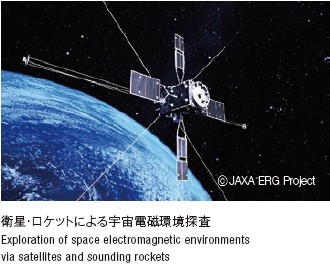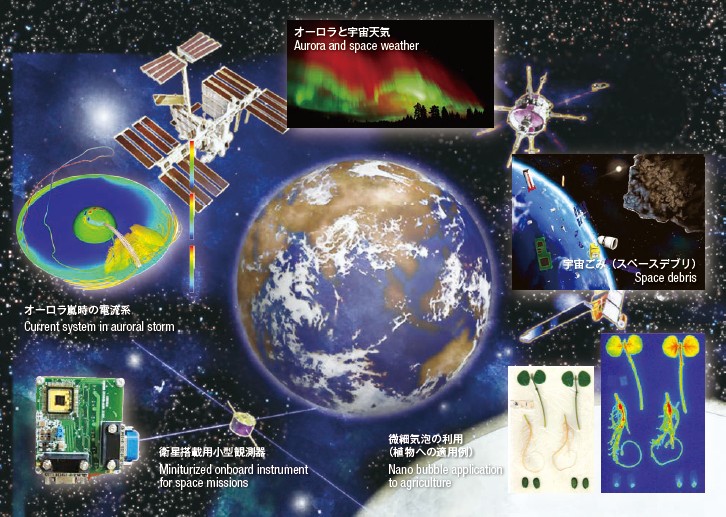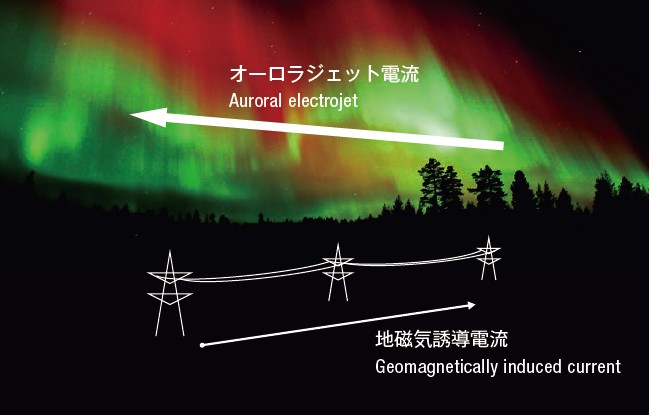ミッション 3:宇宙生存環境
Updated: 2025/04/14
人工衛星、宇宙ステーション、ロケット、地上レーダー、計算機シミュレーションなどをもちいて、宇宙圏・大気圏の理解のための研究を深化・融合させ、生活圏や森林圏との連接性の解明に取り組みます。さらに、太陽フレアを原因とする放射線帯や磁気嵐の変動などの理解を深めて、スペースデブリや地球に接近する小惑星などの宇宙由来の危機への対策を提案できるようにします。気象・測位・通信衛星などの宇宙インフラの維持・発展にも貢献することで、宇宙環境の持続的な利用という社会的要請に応えます。さらには、生存環境への影響が甚大である小惑星の地球との衝突の可能性にそなえて、地球衝突の前に小惑星の軌道の微修正する工学的対応にも取り組みます。新ミッション3では、宇宙圏環境の理解と利用だけでなく、生存環境としての維持・改善、ひいては大気圏、森林圏、生活圏との連接性も重点化します。
研究ハイライト(タイトルをクリックすると関連ページにジャンプします)
宇宙環境を利用・改善する宇宙システムの研究
地球接近小惑星の地球衝突を回避するために、太陽風や帯電現象を利用した小規模な小惑星の軌道変更手法を提案しました。
斜め電波ホイッスラーモード・コーラス波動による放射線帯電子加速の研究
放射線帯電子の加速機構として平行伝搬のホイッスラーモード・コーラス波動のみならず斜め伝搬のコーラス波動が重要な役割を果たしていることをテスト粒子シミュレーションにより初めて明らかにしました。その成果によって、2017年8月19日-26日にカナダ・モントリオールで開催されたURSI(国際電波科学連合)の総会において、大村教授がURSIアップルトン賞を受賞しました。
宇宙プラズマ計算機シミュレーション
太陽活動の変動にともなって、地球をとりまく宇宙環境は大きく変化します。オーロラを光らせる電流・磁場構造や電磁波動の発生にともなう放射線帯粒子の変動を計算機シミュレーションで再現することで、宇宙プラズマ電磁環境変動の理解に寄与します。
地磁気誘導電流の研究
宇宙空間を流れる電流は、地上の送電網などに地磁気誘導電流を流して停電を引き起こすことがあります。宇宙空間と地上との連接を物理的に正しく知り、電力網の安全な運用に貢献します。
宇宙電磁環境の計測
地上や宇宙空間での人類の生存活動に影響を与える宇宙電磁環境の変化を、科学衛星やロケットに搭載した最先端の観測器により探査し、計測データにもとづいて、その構造をあきらかにします。
 |
 |
宇宙用新材料の開発
宇宙圏での生存圏環境の確立にむけて、新しい材料を研究します。具体的には、微細気泡技術、ナノ金属化合物などを考えています。新材料の微細気泡を利用した農業応用研究にも着手しています。






